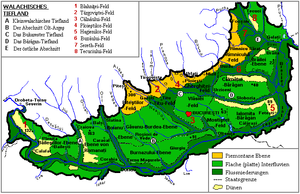- Wallachian Plain
-
Geography of Romania Topography Carpathians (peaks)
Plains & Delta
IslandsHydrography Climate The Romanian Plain (Romanian: Câmpia Română) is located in southern Romania and the easternmost tip of Serbia. Part of the historical region of Wallachia, it is bordered by the Danube River in the east, south and west, and by the Getic Plateau in the north. Bucharest, the capital of Romania, is located in the central part of the Romanian Plain. It is contiguous to the south with the Danubian Plain (Bulgarian: Дунавска равнина), in Bulgaria. This area is also sometimes referred to as the Danubian Plain (Câmpia Dunării) in Romanian, though this designation is not specific, because the Danube flows through a number of plains along its course, such as the Hungarian Plain (which is called Danubian Plain in Slovakia and Serbia) as well as the Bavarian Lowland, also called Danubian plain.
Contents
Subdivisions (W-E)
In Romania, the plain is divided into five subdivisions and the Danube Valley:
- A. Olteniei Plain, located in the southern Oltenia:
- Blahniţei;
- Băileştilor;
- Romanaţilor.
- B. Olt-Argeş (between the Olt River in the west and the Argeș River in the east):
- Piteştiului;
- Boianului;
- Găvanu Burdea;
- Burnazului.
- C. Bucureştilor Plain:
- Târgoviştei;
- Ploieştilor;
- Mizil;
- Titu;
- Gherghiţei;
- Vlăsiei (see also Codrii Vlăsiei);
- Câlnăului.
- D. Bărăgan Plain:
- Bărăganul Călmăţuiului;
- Bărăganul Ialomiţei;
- Câlnăului;
- Mostiştei;
- E. The eastern plain:
- Râmnicului;
- Buzăului;
- Brăilei;
- Siretului Inferior;
- Tecuciului;
- Covurlui;
- Danube Valley:
- The proper Danube valley;
- The flooded marshy islands:
- Insula Mare a Brăilei or Balta Brăilei;
- Balta Ialomiţei.
Rivers
Gallery
-
The Walachian Plain, in the southern part of Argeş County (Piteştilor-Plain)
-
Steppe vegetation in the Burnazului Plain
References
See also
Categories:- Romania geography stubs
- Landforms of Romania
- Plains of Romania
- Wallachia
- Physiographic provinces
- A. Olteniei Plain, located in the southern Oltenia:
Wikimedia Foundation. 2010.




